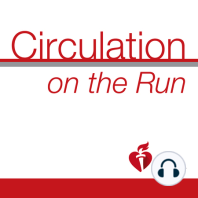23 min listen
Circulation January 9, 2018 Issue
ratings:
Length:
23 minutes
Released:
Jan 8, 2018
Format:
Podcast episode
Description
Dr. Carolyn Lam: Welcome to "Circulation on the Run," your weekly podcast summary and backstage pass to the journal and its editors. I'm Dr. Carolyn Lam, Associate Editor from the National Heart Center and Duke‐National University of Singapore. Our featured discussion this week focuses on the new 2017 ACC/AHA high blood pressure guidelines, and the potential impact of these guidelines on the U.S. population. A must listen, coming right up after these summaries. The first original paper this week provides insights into how extracellular matrix remodeling contributes to in‐stent restenosis and thrombosis. First author, Dr. Suna, corresponding author, Dr. Mayr, and colleagues from King's College London, implanted bare metal and drug‐eluting stents in pig coronary arteries with an overstretch and then harvested the stented segments up to 28 days poststenting for proteomics analysis of the media and neointima. The authors found significant differences by proteomics in the extracellular matrix of coronary arteries after stent implantation. Most notably, an upregulation of aggrecan, a major extracellular matrix component of cartilaginous tissues that confers resistance to compression. In fact, this study provided the first evidence implicating aggrecan and aggrecanases in the vascular injury response after stenting. This opens a door to consideration of aggrecanase activity as new drug targets that may alter extracellular matrix remodeling in the vasculature. The next paper tells us that empagliflozin could address a significant unmet need in patients with chronic kidney disease. First and corresponding author, Dr. Wanner, from Wurzburg University Clinic in Germany investigated the effects of empagliflozin on clinical outcomes in patients with chronic kidney disease in the EMPA‐REG OUTCOME trial, where patients with type 2 diabetes, established cardiovascular disease, and an eGFR above 30 at screening were randomized to receive empagliflozin or placebo, in addition to standard of care. In the current study, prevalent kidney disease was defined as an eGFR of less than 60 or urine albumin/creatinine ratio of more than 300 at baseline. In these patients, empagliflozin reduced the risk of cardiovascular death by 29% compared with placebo, reduced the risk of all‐cause mortality by 24%, and reduced the risk of hospitalization for heart failure by 39%, and the risk of allcause hospitalization by 19%. The effects of empagliflozin on these outcomes were independent of renal function or albuminuria status at baseline. Furthermore, the adverse event profile of empagliflozin was similar across subgroups by renal function at baseline. Adverse events of particular concern in this population, such as urinary tract infection, acute renal failure, hypokalemia or fractures, lower limb amputations or hypoglycemia were not increased with empagliflozin compared to placebo. The next study provides mechanistic insights into exercise intolerance in heart failure with preserved ejection fraction or HFpEF. First author, Dr. Houstis, corresponding author, Dr. Lewis and colleagues from Massachusetts General Hospital, investigated the mechanism of exercise intolerance in 79 patients with HFpEF and 55 controls referred for cardiopulmonary exercise testing who were also studied with invasive monitoring to measure hemodynamics, blood gases and gas exchange during exercise. These measurements were used to quantify six steps of oxygen transport and utilization in each HFpEF patients, identifying the defective steps that impaired each one's exercise capacity. The authors then quantified the functional significance of each pathway defect by calculating the improvement in exercise capacity that a patient could expect from correcting the defect. The authors found that the vast majority of HFpEF patients harbored defects at multiple steps of the pathway, the identity and magnitude of which varied widely. Two of these steps, namely, cardiac output and skeletal muscle oxyg
Released:
Jan 8, 2018
Format:
Podcast episode
Titles in the series (100)
Circulation September 19, 2017 Issue: Circulation Weekly: Your Weekly Summary & Backstage Pass To The Journal by Circulation on the Run
